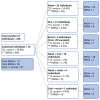Molecular Epidemiology of Staphylococcus aureus and MRSA in Bedridden Patients and Residents of Long-Term Care Facilities
- PMID: 36358181
- PMCID: PMC9686811
- DOI: 10.3390/antibiotics11111526
Molecular Epidemiology of Staphylococcus aureus and MRSA in Bedridden Patients and Residents of Long-Term Care Facilities
Abstract
At present, multidrug-resistant microorganisms are already responsible for community-acquired infections. Methicillin-resistant Staphylococcus aureus (MRSA) poses a serious public health risk worldwide because of the rapid spread and diversification of pandemic clones that are characterized by increasing virulence and antimicrobial resistance. The aim of this study was to identify the prevalence and factors associated with nasal, oral and rectal carriage of S. aureus and MRSA in bedridden patients and residents of long-term care facilities for the elderly (LTCFs) in Botucatu, SP, Brazil. Nasal, oral and rectal swab isolates obtained from 226 LTCF residents or home-bedridden patients between 2017 and 2018 were submitted to susceptibility testing, detection of the mecA gene, SCCmec characterization, and molecular typing by pulsed-field gel electrophoresis (PFGE) and multilocus sequence typing (MLST). Logistic regression analysis was used to identify risk factors associated with the presence of S. aureus and MRSA. The prevalence of S. aureus and MRSA was 33.6% (n = 76) and 8% (n = 18), respectively. At the nine LTCFs studied, the prevalence of S. aureus ranged from 16.6% to 85.7% and that of MRSA from 13.3% to 25%. Living in an LTCF, male gender, a history of surgeries, and a high Charlson Comorbidity Index score were risk factors associated with S. aureus carriage, while MRSA carriage was positively associated with male gender. This study showed a high prevalence of S. aureus among elderly residents of small (<15 residents) and medium-sized (15−49 residents) LTCFs and a higher prevalence of MRSA in the oropharynx.
Keywords: MRSA; Staphylococcus aureus; bedridden patients; elderly population; long-term care facility; molecular epidemiology.
Conflict of interest statement
The authors declare no conflict of interest.
Figures




Similar articles
-
Nasal colonization with methicillin-resistant Staphylococcus aureus among elderly living in nursing homes in Brazil: risk factors and molecular epidemiology.Ann Clin Microbiol Antimicrob. 2018 May 4;17(1):18. doi: 10.1186/s12941-018-0271-z. Ann Clin Microbiol Antimicrob. 2018. PMID: 29728115 Free PMC article.
-
Prevalence of methicillin-resistant Staphylococcus aureus and factors associated with colonization among residents in community long-term-care facilities in Spain.Clin Microbiol Infect. 2008 Sep;14(9):867-72. doi: 10.1111/j.1469-0691.2008.02060.x. Clin Microbiol Infect. 2008. PMID: 18844688
-
Methicillin-resistant Staphylococcus aureus (MRSA) nasal carriage in residents of Veterans Affairs long-term care facilities: role of antimicrobial exposure and MRSA acquisition.Infect Control Hosp Epidemiol. 2012 Jun;33(6):551-7. doi: 10.1086/665711. Epub 2012 Apr 13. Infect Control Hosp Epidemiol. 2012. PMID: 22561709
-
The evolution of Staphylococcus aureus.Infect Genet Evol. 2008 Dec;8(6):747-63. doi: 10.1016/j.meegid.2008.07.007. Epub 2008 Jul 29. Infect Genet Evol. 2008. PMID: 18718557 Review.
-
The molecular evolution of methicillin-resistant Staphylococcus aureus.Clin Microbiol Infect. 2007 Mar;13(3):222-35. doi: 10.1111/j.1469-0691.2006.01573.x. Clin Microbiol Infect. 2007. PMID: 17391376 Review.
References
Grants and funding
LinkOut - more resources
Full Text Sources

